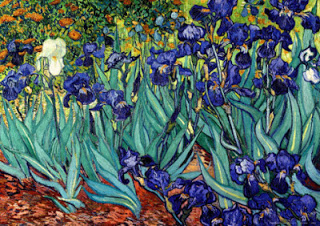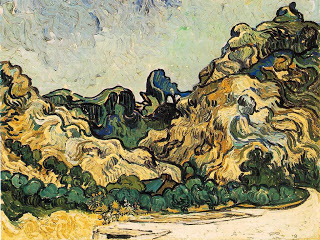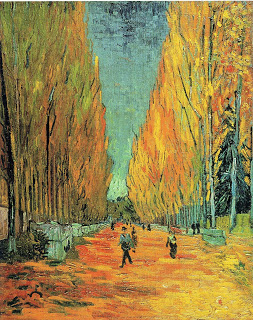I am still mulling over the twists and turns of Vincent Van Gogh's life as an artist, with his highly intelligent reasonings or rationalisations about each phase of his art, especially in his letters to his brother, Theo. So much to think about because, to a greater or lesser extent, most artists can learn a great deal from Van Gogh.
There is a wonderful quote of his in Van Gogh, A Life by Steven Naifeh and Gregory White Smith. Writing in mid 1889, when he was staying at the Asylum of Saint-Paul-de-Mausole, at Saint-Rémy, Van Gogh remarked, "In the open air, one works as best one can, one fills one's canvas regardless. Yet that is how one captures the true and the essential - the most difficult part."
Iris, Saint-Rémy, Van Gogh, oil on canvas, 1889 (Image courtesy of the J. Paul Getty Museum, Los Angeles)
Even before Van Gogh was allowed to leave the asylum to paint further afield, he was "doing little things after nature", like these gem-like Iris. Rather than thinking too much, he was going out to "look at a blade of grass, the branch of a fire tree, an ear of wheat, in order to calm down". Painting as best he could, with spontaneity, and indeed, the essence of irises sings from the canvas.
Landscape from Saint-Rémy, oil on canvas, Van Gogh, 1889 (Image courtesy of NY Carlsberg Glyptotek)
Olive Grove, oil on canvas, Van Gogh, 1889, (Image courtesy of Rijksmuseum Kröller-Müller, Netherlands)
Green Wheat Field with Cypress, oil on canvas, Van Gogh, 1889 (Image courtesy of Národiní Galerie, Prague)
These paintings show the progression of Van Gogh moving further out from the asylum, exploring the Midi landscapes, working en plein air, in heat and wind and sun, trying to capture this wide world in his new-found serenity of mind.
Mountains at Saint-Rémy, oil on canvas, Van Gogh, 1889, (Image courtesy of Solomon R. Guggenheim Museum, NY)
During this amazingly productive time, Van Gogh had found the clarity and peace that allowed him to cast away the fetters of mind and even those of drawing with the aid of his perspective frame. He simply worked "by feeling and by instinct", in the same way, he decided, as the ancient Egyptians had done in their creative work.
I find it interesting that this was a brief time, for Van Gogh, when order, simplicity of living, and a cloistered serenity in the asylum all fostered his creativity. He had the peace of mind and energy to go to the heart of what he was seeing and simply paint and draw.
Time and time again, we get reminders of how solitude and peace help artists to find the "true and the essential" in their art. Agatha Christie found inspiration and amazing productivity in her writing at her beloved home, Greenway, near Torquay, because of the quiet peacefulness there. Author Patrick Leigh Fermor wrote a wonderful small book in 1957, A Time to Keep Silence, about his stay at the Abbey of St. Wandrille de Fontanelle, near Rouen in France. He had gone there to write, but found that once he had become accustomed to the silence and deep orderliness of the life of the Benedictines monks, he was filled with an energy and creativity of "limpid freshness".
We all need that solitude and order in our lives to be able to reach whatever is true and essential to us as artists. Not always so easy in our world of today. We need seriously to organise ourselves and find the discipline to turn off phones, unplug from the computer, make space and time and serenity. But there are rewards.

















